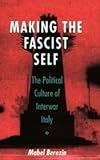Making the Fascist Self : The Political Culture of Interwar Italy / Mabel Berezin.
Material type: TextSeries: The Wilder House series in politics, history, and culturePublisher: Ithaca, NY : Cornell University Press, [2018]Copyright date: ©1997Description: 1 online resource (288 p.) : 15 halftones; 1 map; 5 graphs; 4 tablesContent type:
TextSeries: The Wilder House series in politics, history, and culturePublisher: Ithaca, NY : Cornell University Press, [2018]Copyright date: ©1997Description: 1 online resource (288 p.) : 15 halftones; 1 map; 5 graphs; 4 tablesContent type: - 9781501722141
- 306.2/0945/09041 23
- DG571 .B444 1997eb
- online - DeGruyter
| Item type | Current library | Call number | URL | Status | Notes | Barcode | |
|---|---|---|---|---|---|---|---|
 eBook
eBook
|
Biblioteca "Angelicum" Pont. Univ. S.Tommaso d'Aquino Nuvola online | online - DeGruyter (Browse shelf(Opens below)) | Online access | Not for loan (Accesso limitato) | Accesso per gli utenti autorizzati / Access for authorized users | (dgr)9781501722141 |
Browsing Biblioteca "Angelicum" Pont. Univ. S.Tommaso d'Aquino shelves, Shelving location: Nuvola online Close shelf browser (Hides shelf browser)

|

|

|

|

|

|

|
||
| online - DeGruyter Marxian Socialism in the United States / | online - DeGruyter Stalled Democracy : Capital, Labor, and the Paradox of State-Sponsored Development / | online - DeGruyter Regulating Privacy : Data Protection and Public Policy in Europe and the United States / | online - DeGruyter Making the Fascist Self : The Political Culture of Interwar Italy / | online - DeGruyter National Diversity and Global Capitalism / | online - DeGruyter Alternatives to Lean Production : Work Organization in the Swedish Auto Industry / | online - DeGruyter Rhodes in the Hellenistic Age / |
Frontmatter -- Contents -- Acknowledgments -- Chronology -- Abbreviations -- Introduction: Post-Fascism/Fascism: Italy I994/I922 -- 1. Interpreting Fascism/Explaining Ritual -- 2. Imagining a New Political Community: The Landscape of Ritual Action -- 3. Convergence and Commemoration: Reenacting the March on Rome -- 4. The Evolution of Ritual Genres: The March Continues -- 5. Colonizing Time: Rhythms of Fascist Ritual in Verona -- 6. Dead Bodies and Live Voices: Locating the Fascist Self -- Conclusion: Fascism/Identity /Ritual -- Methodological Appendix -- Index
restricted access online access with authorization star
http://purl.org/coar/access_right/c_16ec
In her examination of the culture of Italian fascism, Mabel Berezin focuses on how Mussolini's regime consciously constructed a nonliberal public sphere to support its political aims. Fascism stresses form over content, she believes, and the regime tried to build its political support through the careful construction and manipulation of public spectacles or rituals such as parades, commemoration ceremonies, and holiday festivities.The fascists believed they could rely on the motivating power of spectacle, and experiential symbols. In contrast with the liberal democratic notion of separable public and private selves, Italian fascism attempted to merge the public and private selves in political spectacles, creating communities of feeling in public piazzas. Such communities were only temporary, Berezin explains, and fascist identity was only formed to the extent that it could be articulated in a language of pre-existing cultural identities.In the Italian case, those identities meant the popular culture of Roman Catholicism and the cult of motherhood. Berezin hypothesizes that at particular historical moments certain social groups which perceive the division of public and private self as untenable on cultural grounds will gain political ascendance. Her hypothesis opens a new perspective on how fascism works.
Mode of access: Internet via World Wide Web.
In English.
Description based on online resource; title from PDF title page (publisher's Web site, viewed 26. Apr 2024)


